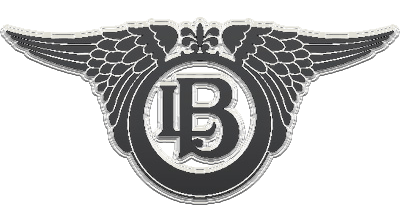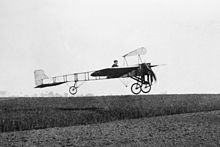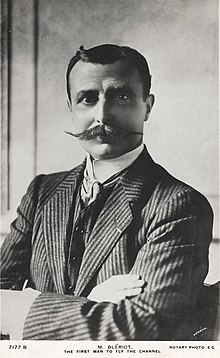 |
|
| Thulin A (licence-built Blériot XI) | |
| Role | Civil tourer/trainer/military |
|---|---|
| Manufacturer | Louis Blériot |
| Designer | Louis Blériot and Raymond Saulnier |
| First flight | 23 January 1909; 115 years ago |
| Status | Active |
| Number built | 103 |

The Blériot Memorial, the outline of the aircraft laid out in granite setts in the turf (funded by oil manufacturer Alexander Duckham), marks his landing spot above the cliffs near Dover Castle. 51.1312°N 1.326°E. The aircraft which was used in the crossing is now preserved in the Musée des Arts et Métiers in Paris.


At 4:15 am, 25 July, watched by an excited crowd, Blériot made a short trial flight in his Type XI, and then, on a signal that the sun had risen (the competition rules required a flight between sunrise and sunset), he took off at 4:41 to attempt the crossing. Flying at approximately 45 mph (72 km/h) and an altitude of about 250 ft (76 m), he set off across the Channel. Not having a compass, Blériot took his course from the Escopette, which was heading for Dover, but he soon overtook the ship. The visibility deteriorated, and he later said, "for more than 10 minutes I was alone, isolated, lost in the midst of the immense sea, and I did not see anything on the horizon or a single ship". The grey line of the English coast, however, came into sight on his left; the wind had increased, and had blown him to the east of his intended course. Altering course, he followed the line of the coast about a mile offshore until he spotted Charles Fontaine, the correspondent from Le Matin waving a large Tricolour as a signal. Unlike Latham, Blériot had not visited Dover to find a suitable spot to land, and the choice had been made by Fontaine, who had selected a patch of gently sloping land called Northfall Meadow, close to Dover Castle, on top of the cliffs. Once over land, Blériot circled twice to lose height, and cut his engine at an altitude of about 20 m (66 ft), making a heavy "pancake" landing due to the gusty wind conditions; the undercarriage was damaged and one blade of the propeller was shattered, but Blériot was unhurt. The flight had taken 36 minutes and 30 seconds..
Ceiling
MAX RANGE
Aircraft Speed
Max Crew


 |
|
| Born | Louis Charles Joseph Blériot1 July 1872Cambrai, France[1] |
|---|---|
| Died | 1 August 1936 (aged 64) Paris, France |
| Alma mater | École Centrale Paris |
| Occupation(s) | Inventor and engineer |
| Known for | First heavier-than-air flight across the English Channel,first working monoplane |
| Spouse | Alice Védère (1901) (1883-1963) |
| Awards | Comman |
The Blériot Type XI was designed primarily by Raymond Saulnier, but it was a natural evolution from earlier Blériot aircraft, and one to which Louis Blériot himself made substantial contributions.
The Blériot XI in the NASM collection was manufactured in 1914
The Blériot XI in the NASM collection was manufactured in 1914 and was powered by a 50-horsepower Gnôme rotary engine